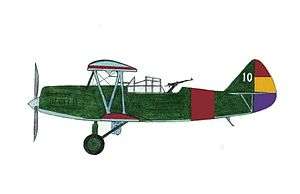Polikarpov R-Z
| R-Z | |
|---|---|
 | |
| Polikarpov R-Z "Natacha" of the Spanish Republican Air Force | |
| Role | Reconnaissance/Light Bomber |
| Manufacturer | Polikarpov |
| First flight | 1935 |
| Introduction | 1935 |
| Primary user | Soviet Air Force |
| Number built | 1,031 |
| Developed from | Polikarpov R-5 |
The Polikarpov R-Z was a Soviet reconnaissance bomber aircraft of the 1930s. It was a revised version of the Polikarpov R-5 which was built in large numbers between 1935 and 1937. It was used in combat during the Spanish Civil War as well as the Winter War and Battle of Khalkhin Gol.
Development and design
The R-Z or R-Zet was developed at the aircraft factory GAZ No 1 (State Aircraft Factory No 1) at Moscow as a development of, and a replacement for the Polikarpov R-5, the standard light reconnaissance bomber of the Soviet Air Force. Based on the R-5SSS, the most advanced variant of the R-5, the R-Z had a new, deeper, monocoque fuselage, with a sliding canopy for the pilot and fixed glazed fairing for the observer. The 544 kW (730 hp) M-17F engine (a licensed built copy of the BMW VI was replaced with the 611 kW (820 hp) M-34 engine. The R-Z first flew in January 1935 [1] and was accepted for the Soviet Air Force in preference to the competing Kochyerigin LR, also an R-5 derivative. By the time production finished in spring 1937, 1,031 R-Zs had been built.[1]
Operational history
Like its predecessor the R-5, the R-Z was used in large numbers by both the Soviet Air Force and Aeroflot.
Its first use in combat was during the Spanish Civil War from 1937. 61 R-Zs were delivered to the Spanish Republican Air Force,[2] where they were nicknamed Natacha.[3] These were heavily used, flying in tight formations and using co-ordinated defensive fire to defend against fighter attack, while returning individually at low levels.[2] Although many R-Zs were damaged by ground fire, and the 2ª Escuadrilla, Grupo 30 lost 9 of their 60 aircraft in one day on 24 December 1938,[4] complete losses were relatively low [5] with 36 surviving to be captured by the Nationalists at the end of the war in April 1939.[6]
R-Zs were used by the Soviet air force against Japan above Mongolia in the Battle of Khalkhin Gol in 1939, and the Winter War against Finland in the same year.[1] By the time of the German invasion of the Soviet Union in June 1941, the R-Z was in the process of being replaced by the Ilyushin Il-2, although it remained in service with a number of light bomber regiments.[6]
Variants
- R-Z
- Main production reconnaissance bomber. Powered by M-34N engine.
- R-ZSh
- Shturmovik. Single ground attack prototype armed with four ShKAS machine guns in lower wing.
- P-Z
- Commercial variant with limited changes used for carrying mail and/or two passengers. Produced in considerable numbers. Powered by M-34NB engine.
- PT
- Attempt at improved civil version with streamlined containers for cargo above lower wing. Unsuccessful, only one built.
- R-ZR
- Single seat conversion for record breaking purposes. One built. Flown to 11,100 m (36,417 ft) on 8 May 1937
Operators
Specifications (R-Z)
Data from The Osprey Encyclopedia of Russian Aircraft from 1875 - 1995 [1]
General characteristics
- Crew: 2
- Length: 9.72 m (34 ft 7½ in)
- Wingspan: 15.45 m (50 ft 8¼ in)
- Height: 3.60 m [6] (11 ft 9¾ in)
- Wing area: 42.5 m² (458 ft²)
- Empty weight: 2,007 kg (4,425 lb)
- Loaded weight: 3,150 kg (6,945 lb)
- Powerplant: 1 × Mikulin AM-34 water cooled V-12, 611 kW (820 hp)
Performance
- Maximum speed: 316 km/h (171 kn, 196 mph) at 3,500 m (11,483 ft)
- Range: 1,000 km (540 nmi, 621 mi)
- Service ceiling: 8,700 m (28,543 ft)
- Wing loading: 74.1 kg/m² (15.2 lb/ft²)
- Power/mass: 0.19 kW/kg (0.12 hp/lb)
- Climb to 3,000 m (9,843 ft): 6.6 min
Armament
- 1 × fixed forward firing PV-1 machine gun and 1 or 2 × ShKAS machine guns in rear cockpit
- Up to 400 kg (882 lb) bombs
See also
- Related development
- Aircraft of comparable role, configuration and era
- Related lists
References
- 1 2 3 4 Gunston, Bill (1995). The Osprey Encyclopedia of Russian Aircraft from 1875 - 1995. London: Osprey Aerospace. ISBN 1-85532-405-9.
- 1 2 "Polikarpov R-Z (Zet) Поликарпов Р-Z (Зет)" (in Russian). Retrieved 2007-07-31.
- ↑ Asociación de Aviadores de la República - Polikarpov RZ Natacha
- ↑ Ejército del Aire; Historia - 1938
- ↑ "República - Aviones de bombardeo" (in Spanish). Retrieved 2007-07-29.
- 1 2 3 Donald, David (Editor) (1997). The Encyclopedia of World Aircraft. Aerospace Publishing. ISBN 1-85605-375-X.
External links
| Wikimedia Commons has media related to Polikarpov R-Z. |